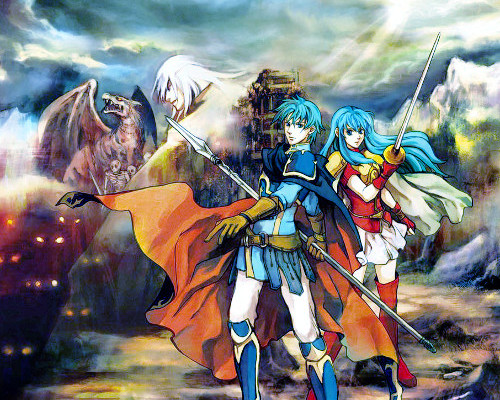Fire Emblem: The Sacred Stones is a turn-based strategy RPG game released on the Gameboy Advance platform in 2005 (English version). It is the eighth title in the Fire Emblem series, and the third (and final) game released on the platform. The other two titles are Fire Emblem: The Blazing Sword and Fire Emblem: Binding Sword.
This game focus on two royal twins of Renais, whose king father Fado was killed, and their nation fell to the sudden invasion of their long-time ally, the kingdom of Grado. In addition to that, there were monsters appearing all over the continent. This is the only Fire Emblem title on the Gameboy Advance platform that has monsters.

Similar to Fire Emblem: Path of Radiance, this game took place on an entirely different continent from its prequels — the continent of Magvel. There were 6 nations in the continent, namely,
The kingdom of Renais, is ruled by King Fado, the father of the two protagonists in Fire Emblem: The Sacred Stones, Ephraim and Eirika.

The kingdom of Frelia was ruled by King Hayden, the father of Tana and Innes. Tana is a close friend of the two protagonists, while Innes is a rival (in a good way) of Ephraim.
The kingdom of Jehanna is ruled by Queen Ismaire, the mother of Joshua, is one of my favorite character in game.
The Theocracy of Rausten, ruled by Divine Emperor Mansel, the father of L’Arachel.
The Grado Empire was ruled by Emperor Vigarde. This is the main antagonist kingdom. Vigarde’s son, Lyon is the best friend of the two protagonists.
The above five nations are all founded by the Five Heroes of Magvel — they are the ones who once used the Sacred Stone to defeat and seal the demon king long ago. The above five nations were named after them.
The sixth nation, Merchantile Republic of Carcino, is governed by a council of elders. I mention this nation simply because it is “incomplete” if I only talk about the other five nations. 🙂

In general, Fire Emblem: The Sacred Stones is pretty similar to its previous titles on the Gameboy Advance platform, except for some new features such as the map system and the leveling-up process.
Firstly, the map system is something entirely new — in previous titles, players are only allowed to play the game chapters, with no freedom in revisiting towns which they have gone past. In this title, players are allowed to move around freely as well as fight the monsters randomly generated on the world map.

Gameplay-wise, it is very similar to its previous titles in the Fire Emblem series; players can easily have an edge over their opponents if they fully utilize the weapon triangle and trinity of magic (zombies are weak against light magic). Terrain as well is your best friend. Read more about my past posts on these features.

Of course, similar to all other Fire Emblem titles, there are conversation dialogues between characters, and also, support dialogues which allow characters to have stats boost when standing adjacent to one another.

When you keep using a certain weapon to attack your enemies, you will allow it to gain weapon experience (a yellow bar) and when it reaches a maximum, it will increase in its level and reset the bar to empty again. In the screenshot above, Joshua has his Sword level rank “S”, which means he can equip almost any sword weapon. The following shows Ephraim, who only has a rank “A” in his lances.

The other great feature added into this game which makes it more interesting is its leveling-up process. Players can now choose which class to promote their characters too. For example, a monk can choose between upgrading into a sage or a bishop, and a cleric can choose between upgrading into a bishop or valkyrie.

There is really not much to be picky about. Perhaps, I would say that the number of characters which you can recruit in this game is considered to be quite little somehow, perhaps because you can choose the promotion yourself — so if you use some promotion “wrongly”, you can never get to try all the different playable classes in the game.

An interesting new class in this game is that there are a few characters who start with a class even lower than the basic class. They will auto-promote into one of the basic classes upon reaching level 10 though. This allows players to even further, plan the “class route” for this character. These classes are pupil, journeyman, and recruit.
Of course, despite being the official (English) North America version, there are still some spelling or translation mistakes here and there. I managed to screenshot one of them as an example though, as follows.

It should be “I wish that there were some ways I could help you, but I simply can’t” instead of “I would that there were some ways I could help you, but I simply can’t”.
All in all, Fire Emblem: The Sacred Stones is an awesome game to play. However, if I have to choose a winner among the three Fire Emblem titles on the Gameboy Advance platform, it would definitely be Fire Emblem: The Blazing Sword.

Like this game? Try the other Fire Emblem titles too:
- Fire Emblem: Rekka No Ken (GBA)
- Fire Emblem: Fuuin no Tsurugi (GBA)
- Fire Emblem: Path of Radiance (GameCube)
- Fire Emblem: Shadow Dragon (NDS)

Leave a Reply